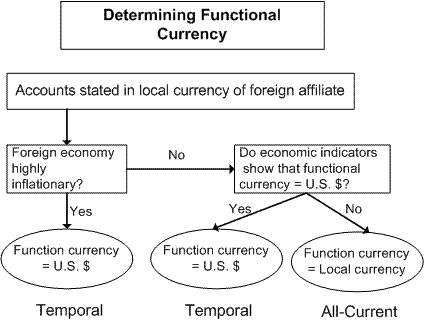- CFA Exams
- 2026 Level II
- Topic 3. Financial Statement Analysis
- Learning Module 12. Multinational Operations
- Subject 2. Role of the Functional Currency
Seeing is believing!
Before you order, simply sign up for a free user account and in seconds you'll be experiencing the best in CFA exam preparation.
Subject 2. Role of the Functional Currency PDF Download
The presentation currency is the currency the parent uses to report its financial statements in its required filings. The SEC, for example, requires all companies selling securities in U.S. stock exchanges to use the $US as the presentation currency.
To determine whether a subsidiary is integrated with the parent or operates independently, SFAS 52 introduced the concept of functional currency. A company's functional currency is the primary currency of the foreign entity's operating environment.
Factors to be considered include cash flows, sales markets, expenses, input sources, financing, and inter-company transactions.
- If the subsidiary's operations are relatively self-contained and integrated within a particular country, the functional currency will generally be the local currency of that country. The all-current method is used.
- If the subsidiary's operations are a direct and integral component of the parent's operations, the functional currency will generally be the parent (reporting) currency. The temporal method is used.
- SFAS 52 mandates the use of the parent (reporting) currency as the functional currency for foreign operations in highly inflationary economies.

The choice is based on management judgment, and the functional currency may be the subsidiary's local currency, the parent's presentation currency, or a third currency.
User Contributed Comments 4
| User | Comment |
|---|---|
| danlan2 | 1)self-contained and integrated within a particular country: functioonal currency=local currency, all-current method; 2)Direct and integral components of parent's operations: functional currency=reporting currency, temporal method; 3)In highly inflational economies, functional currency must be reporting currency. |
| jennystalk | First, it's decided by the choice of management |
| yly14 | Think of a US entity (X) doing business with Japan. X would need to convert all its transactions in Jpn Yen to US dollar at the time of transaction (historical rate). Now consider Y, who is X's subsidiary in Japan, that performs these transactions, meaning that Y's operations are "a direct and integral component of the parent's operations", TEMPORAL method applies. |
| thebkr777 | Once the functional currency is determined, then the proper method for reporting will be determined: If the local differs from the functional currency, then the temporal method is used to remeasure the local currency into the functional currency; if the functional currency differs from the presentation currency, then the current rate method is used to translate the functional currency to the presentation currency. |

Thanks again for your wonderful site ... it definitely made the difference.

Craig Baugh
My Own Flashcard
No flashcard found. Add a private flashcard for the subject.
Add